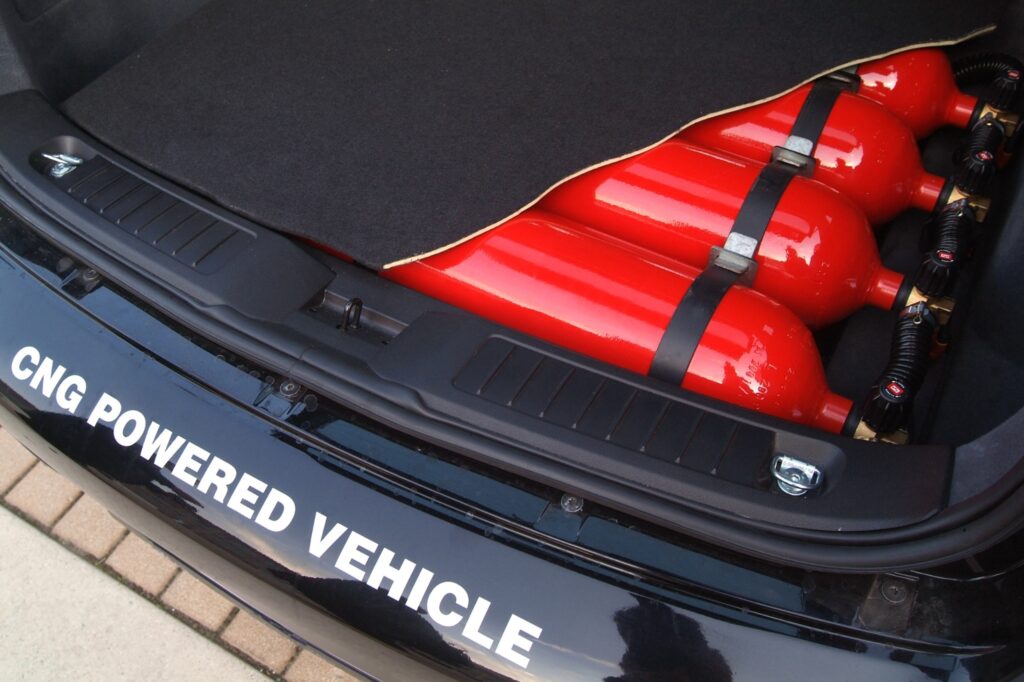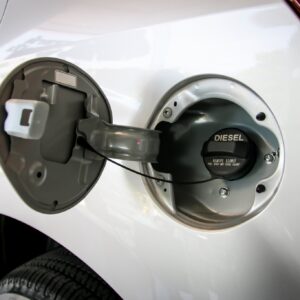Natural gas vehicles are a popular alternative to gas-powered cars. Their engines are powered by compressed natural gas, a clean-burning fuel that produces less emissions and costs less than either gasoline or diesel.
But how exactly do they work and what are their pros and cons?
How Do Natural Gas Vehicles Work?

Compressed natural gas vehicles are similar to gas-powered vehicles in the sense that both draw power from a reservoir located inside the body.
What makes the two different is the fact that natural gas vehicles store their fuel reserves in a tank or cylinder at the back of the vehicle. This fuel, which exists in gaseous form, is transferred from the tank into the engine through fuel lines.
Pressure regulators reduce the pressure of the gas to a level compatible with the engine’s fuel injection system. From here, the fuel goes to the intake manifold or combustion chamber where it mixes with the air, compresses, and is ignited by a spark plug which powers the engine.
Natural Gas Vehicle Types
There are three types of natural gas vehicles: dedicated, bi-fuel, and dual-fuel natural gas vehicles.
- Dedicated: These vehicles run solely on natural gas and cannot use other types of fuel.
- Bi-Fuel: These vehicles can run on either natural gas or gasoline.
- Dual-Fuel: These vehicles need both natural gas and gasoline to work, typically running on the former but requiring the latter for ignition.
Natural Gas Vehicle Pros and Cons
If you plan on driving a natural gas vehicle, it’s important to familiarize yourself with its benefits and drawbacks.
Advantages of Driving a Natural Gas Vehicle
The biggest pros that come with driving a natural gas vehicle include cost-effective fuel, less emissions, prolonged engine life, and more energy security.
Cost-Effective Fuel
Natural gas as a fuel source is typically cheaper than gasoline or diesel, making it an excellent option for drivers keen on saving money in the long run. Though the exact cost of natural gas varies depending on the location and supply, it’s still considered a cheaper alternative to traditional fuel.
Lowers Emissions
A natural gas vehicle produces less emissions than traditional gas-powered vehicles. Natural gas produces less carbon monoxide, nitrogen oxides, and particulate matter when burned.
Moreover, natural gas cars are not just better for the environment. They’re also good for people’s health, as you won’t have to worry about contributing to respiratory problems and other diseases as you drive.
Prolongs Engine Life
Natural gas as a fuel source produces less carbon buildup when it’s combusted compared to gasoline, which means drivers can expect less engine wear and longer engine life. Carbon buildup negatively affects engine performance by obstructing airflow and fuel delivery.
Reduces Reliance on Foreign Oil
Natural gas in vehicles also promotes energy security. Because compressed natural gases are often domestically produced, you won’t have to rely on foreign oil. Gasoline prices tend to fluctuate and shift to fit global oil prices — a problem you won’t have to worry about with natural gas as a fuel source.
Disadvantages of Driving a Natural Gas Vehicle
Though natural gas vehicles come with a lot of benefits, they also come with a lot of drawbacks. Such problems include more frequent refueling, fuel not being as easy to obtain, and high initial costs. Natural gas is also extremely flammable, more so than regular gasoline, making it more dangerous to use if mismanaged.
Frequent Refueling
One of the biggest downsides of using a natural gas vehicle is that compressed natural gas has lower energy density than gasoline. This means you won’t be able to drive as far without refueling compared to gas-powered vehicles.
The need for frequent refueling is a serious concern for drivers who travel between states or make long-distance drives regularly.
Natural Gas Is Not Easily Available
Compressed natural gases aren’t as readily available as gasoline and diesel. Before committing to a natural gas vehicle, you need to make sure there are fueling stations that offer natural gases in your area.
Likewise, you’ll need to take extra care when planning road trips and interstate drives because appropriate gas stations might be limited.
High Initial Costs
Though natural gas is a cheaper source of fuel than gasoline, natural gas vehicles themselves tend to cost more. This is largely because these vehicles require specialized storage tanks or cylinders.
Highly Flammable
Compressed natural gases are highly flammable. You’ll need to take extra care when handling them to avoid potential explosions. You’ll also need to go the extra mile and check if your vehicle is built to strict safety standards.
Any information provided on this Website is for informational purposes only and is not intended to replace consultation with a professional mechanic. The accuracy and timeliness of the information may change from the time of publication.



















